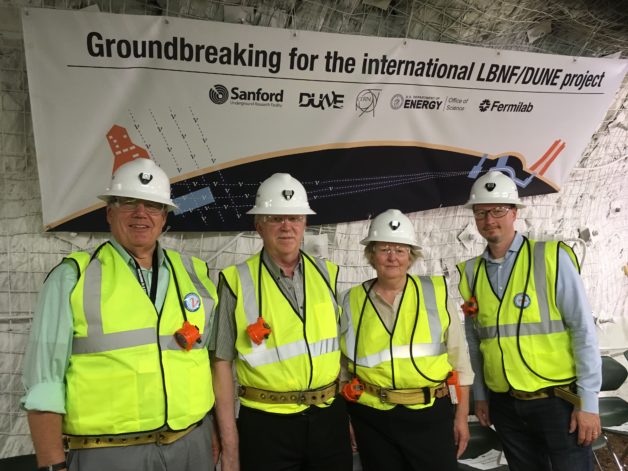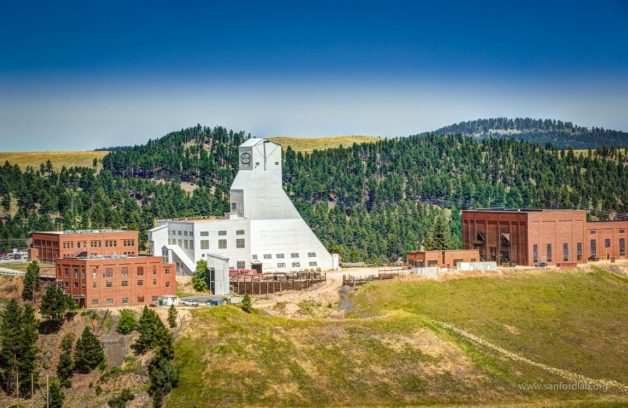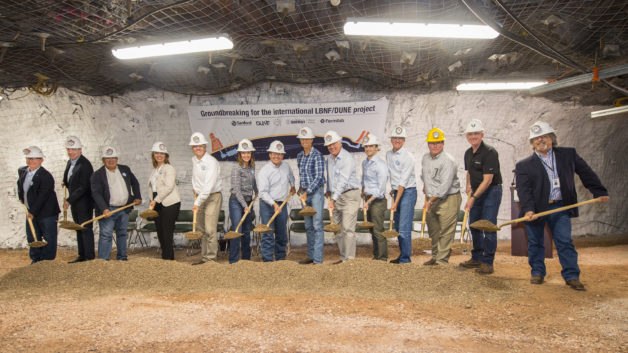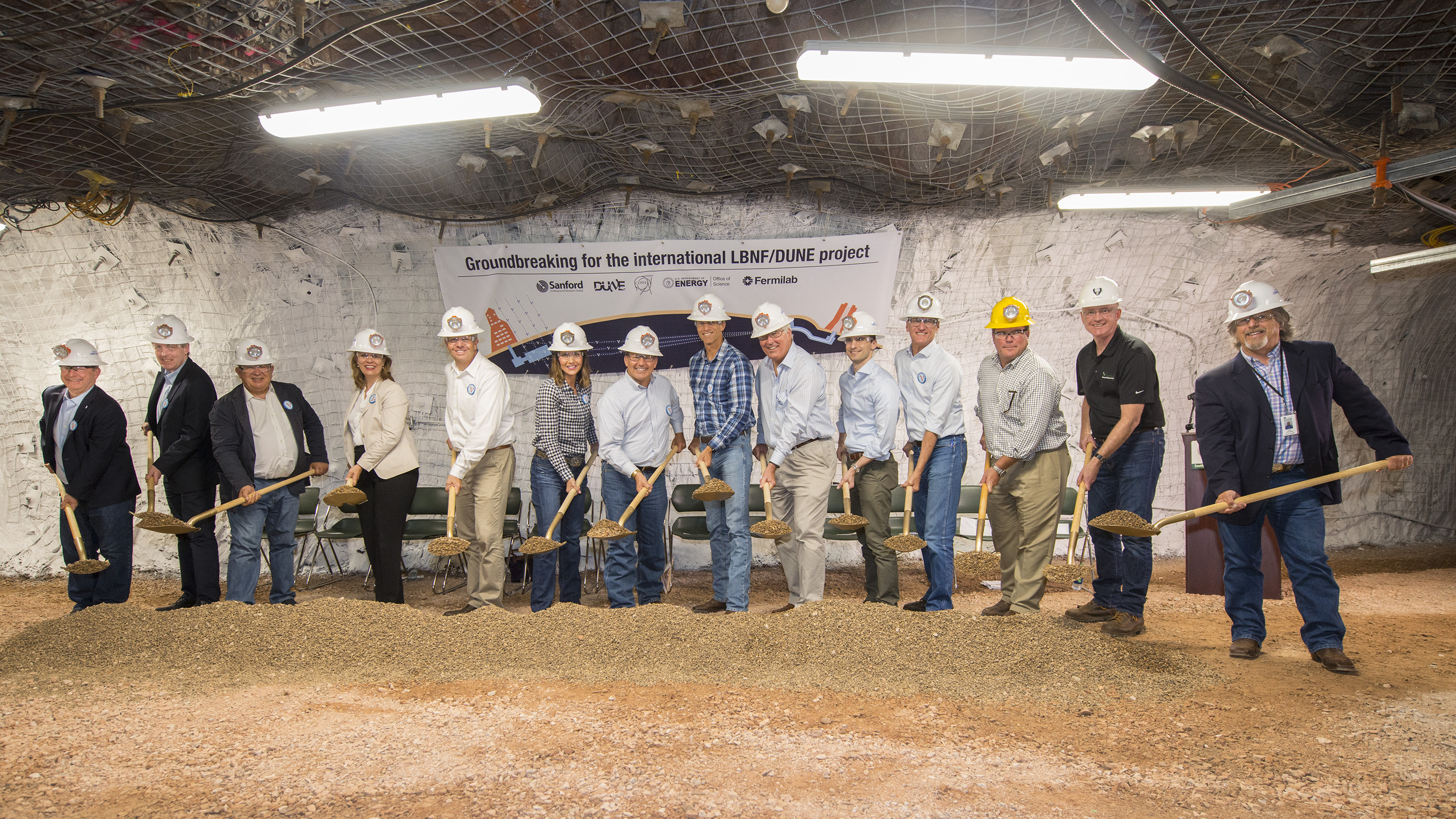With the turning of a shovelful of earth a mile underground, a new era in international particle physics research officially began today.
In a unique groundbreaking ceremony held this afternoon at the Sanford Underground Research Facility (SURF) in Lead, South Dakota, a group of dignitaries, scientists and engineers from around the world marked the start of construction of a massive international experiment that could change our understanding of the universe.
The Long-Baseline Neutrino Facility (LBNF) will house the international Deep Underground Neutrino Experiment (DUNE), which will be built and operated by a group of roughly 1,000 scientists and engineers from 30 countries.
When complete, LBNF/DUNE will be the largest experiment ever built in the U.S. to study the properties of mysterious particles called neutrinos. Unlocking the mysteries of these particles could help explain more about how the universe works and why matter exists at all.
The DOE’s Fermi National Accelerator Laboratory (Fermilab), located outside Chicago, will generate a beam of neutrinos and send them 1,300 kilometers (800 miles) through the Earth to Sanford Lab, where a four-story-high, 70,000-ton detector will be built beneath the surface to catch those neutrinos.
“We are very pleased to see this critical first step in creating a world-class physics experiment at the Sanford Underground Research Facility, which Berkeley Lab managed and oversaw from its conception until 2016,” said Berkeley Lab Director Michael Witherell.
“Our scientists have also participated in a diverse range of research projects at the site,” he added, “and Berkeley Lab is now leading the LUX-ZEPLIN dark matter search experiment that will be built nearly a mile deep at SURF. We look forward to playing key roles in DUNE as this experiment develops, and to our continuing involvement in science at SURF.” Witherell, who has expertise in high-energy physics, is part of an international team that designed the LUX-ZEPLIN (LZ) project. That project is scheduled for completion in 2020.

Berkeley Lab’s Kem Robinson, left, participates in a July 21 tour of the underground site where a new neutrino experiment will be constructed. Also pictured (from left to right) are David MacFarlane of SLAC National Accelerator Laboratory, chairperson of the Long Baseline Neutrino Committee (LBNC); Fermi National Accelerator Laboratory’s Elaine McCluskey, the Long Baseline Neutrino Facility’s project manager; and Tim Meyer, Fermilab’s chief operating officer. Robinson, laboratory project management officer at Berkeley Lab, is a member of the LBNC. (Photo courtesy of Kem Robinson/Berkeley Lab)
Fermilab Director Nigel Lockyer said, “Fermilab is proud to host the Long-Baseline Neutrino Facility and the Deep Underground Neutrino Experiment, which bring together scientists from 30 countries in a quest to understand the neutrino. This is a true landmark day and the start of a new era in global neutrino physics.”
At its peak, construction of LBNF is expected to create almost 2,000 jobs throughout South Dakota and a similar number of jobs in Illinois. The U.S. Department of Energy’s Lawrence Berkeley National Laboratory (Berkeley Lab) is among institutions in dozens of countries that will contribute to the science of DUNE or to the construction of its components. The DUNE experiment will attract students and young scientists from around the world, helping to foster the next generation of leaders in the field and to maintain the highly skilled scientific workforce in the U.S. and worldwide.
Ed Blucher, the DUNE collaboration co-spokesperson and a University of Chicago professor, said, “Today is extremely exciting for all of us in the DUNE collaboration. It marks the start of an incredibly challenging and ambitious experiment that could have a profound impact on our understanding of the universe.”

Surface facilities at the site of the Sanford Underground Research Facility in South Dakota. (Credit: Sanford Lab)
DUNE scientists will study the interactions of neutrinos in the detector, looking to better understand the changes these particles undergo as they travel across the country in less than the blink of an eye. Ever since their discovery 61 years ago, neutrinos have proven to be one of the most surprising subatomic particles, and the fact that they oscillate between three different states is one of their biggest surprises. That discovery began with a solar neutrino experiment led by physicist Ray Davis in the 1960s, performed in the same underground mine that now will house LBNF/DUNE. Davis shared the Nobel Prize in physics in 2002 for his experiment.
Scientists will also look for the differences in behavior between neutrinos and their antimatter counterparts, antineutrinos, which could give us clues as to why the visible universe is dominated by matter. DUNE will also watch for neutrinos produced when a star explodes, which could reveal the formation of neutron stars and black holes, and will investigate whether protons live forever or eventually decay, bringing us closer to fulfilling Einstein’s dream of a grand unified theory.
DUNE will be built over the next 10 years. Now that the first shovel of earth has been moved, crews will begin to excavate more than 870,000 tons of rock to create the huge underground caverns for the DUNE detector. Large DUNE prototype detectors are under construction at European research center CERN, a major partner in the project, and the technology refined for those smaller versions will be tested and scaled up when the massive DUNE detectors are built.
This research is funded by the U.S. Department of Energy Office of Science in conjunction with CERN and international partners from 30 countries. DUNE collaborators come from institutions in Armenia, Brazil, Bulgaria, Canada, Chile, China, Colombia, Czech Republic, Finland, France, Greece, India, Iran, Italy, Japan, Madagascar, Mexico, the Netherlands, Peru, Poland, Romania, Russia, South Korea, Spain, Sweden, Switzerland, Turkey, Ukraine, United Kingdom and the United States.

Ground is broken! Attending the underground ceremony today were, from left: Fermilab Director Nigel Lockyer; Executive Director of Programmes Grahame Blair, Science and Technology Facilities Council; Professor Sergio Bertolucci, National Institute for Nuclear Physics in Italy; Director for International Relations Charlotte Warakaulle, CERN; Rep. Randy Hultgren, Illinois; Rep. Kristi Noem, South Dakota; Sen. Mike Rounds, South Dakota; Sen. John Thune, South Dakota; Associate Director of Science for High-Energy Research Jim Siegrist, U.S. Department of Energy; Deputy Assistant to the President and Deputy U.S. Chief Technology Officer Michael Kratsios; South Dakota Governor Dennis Daugaard; Project Manager Scott Lundgren, Kiewit/Alberici; Executive Director Mike Headley, Sanford Underground Research Facility; and Chair of the Board Casey Peterson, South Dakota Science and Technology Authority. (Credit: Reidar Hahn/Fermilab)
This press release is adapted from an LBNF/DUNE collaboration press release. View the original release.
###
Lawrence Berkeley National Laboratory addresses the world’s most urgent scientific challenges by advancing sustainable energy, protecting human health, creating new materials, and revealing the origin and fate of the universe. Founded in 1931, Berkeley Lab’s scientific expertise has been recognized with 13 Nobel Prizes. The University of California manages Berkeley Lab for the U.S. Department of Energy’s Office of Science. For more, visit www.lbl.gov.
DOE’s Office of Science is the single largest supporter of basic research in the physical sciences in the United States, and is working to address some of the most pressing challenges of our time. For more information, please visit the Office of Science website at science.energy.gov.
The Sanford Underground Research Facility’s mission is to enable compelling underground, interdisciplinary research in a safe work environment and to inspire our next generation through science, technology, engineering, and math education. For more information, please visit the Sanford Lab website at http://www.sanfordlab.org.
